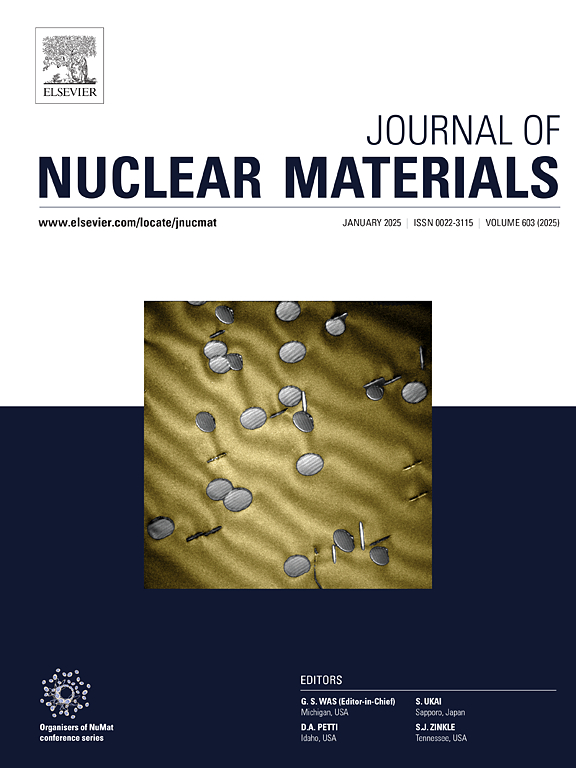高温质子辐照下单晶二氧化钍的缺陷环和完美环演化
IF 3.2
2区 工程技术
Q3 MATERIALS SCIENCE, MULTIDISCIPLINARY
引用次数: 0
摘要
核燃料经历了显著的微观结构演变,导致热导率降低,机械性能改变,并影响其在运行环境中保留裂变产物的能力,严重影响反应堆的性能。这种变化主要是由于固体沉淀和惰性气泡形式的裂变产物的积累,以及辐射诱导缺陷积累后燃料的重组。特别是在辐射损伤范围内,断裂环的形成和演化在随后的位错演化、晶粒细分和再结晶过程中起着至关重要的作用,从而降低了燃料的物理性能。本研究的重点是在1000°C下0.42,0.62和0.74 dpa剂量的质子辐照下,单晶ThO2中断裂和完美回路的动力学,以及未断裂过程。利用透射电子显微镜表征和聚类动力学模型揭示了成核和生长的机制,以及断裂环的不断裂,这是驱动缺陷演变的关键。在本研究中,我们的研究结果表明,断环不断裂的临界直径约为2 nm。此外,从建模结果中发现,不断裂率与位错环密度成线性关系,与环半径成二次关系,突出了缺陷演变与微观结构参数的复杂依赖关系。本文章由计算机程序翻译,如有差异,请以英文原文为准。
Faulted and Perfect Loop Evolution in Single Crystal Thorium Dioxide under High-Temperature Proton Irradiation
Nuclear fuels experience a pronounced microstructural evolution leading to reduction in thermal conductivity, changes in mechanical properties, and impacting their ability to retain fission products in operational environments, significantly affecting reactor’s performance. Such changes result primarily from accumulation of fission products in the form of solid precipitates and inert gas bubbles, and fuel restructuring upon accumulation of radiation-induced defects. Particularly within the realm of radiation damage, the formation and evolution of faulted loops play a critical role in subsequent evolution of dislocations, grain subdivision and recrystallization degrading fuel’s physical properties. This research focused on the dynamics of faulted and perfect loops, alongside the unfaulting process, in single crystal ThO2 subjected to proton-irradiation at doses of 0.42, 0.62, and 0.74 dpa at 1000 °C. Transmission electron microscopy characterization and cluster dynamics modeling were employed to uncover the mechanisms of nucleation and growth, and unfaulting of faulted loops, which are crucial in driving the evolution of defects. In this study, our findings suggested that the critical diameter for faulted loop unfaulting was approximately 2 nm. Moreover, the rate of unfaulting was found to scale linearly with the dislocation loop density and quadratically with the loop radius from the modeling results, highlighting the intricate dependence of defect evolution on microstructural parameters.
求助全文
通过发布文献求助,成功后即可免费获取论文全文。
去求助
来源期刊

Journal of Nuclear Materials
工程技术-材料科学:综合
CiteScore
5.70
自引率
25.80%
发文量
601
审稿时长
63 days
期刊介绍:
The Journal of Nuclear Materials publishes high quality papers in materials research for nuclear applications, primarily fission reactors, fusion reactors, and similar environments including radiation areas of charged particle accelerators. Both original research and critical review papers covering experimental, theoretical, and computational aspects of either fundamental or applied nature are welcome.
The breadth of the field is such that a wide range of processes and properties in the field of materials science and engineering is of interest to the readership, spanning atom-scale processes, microstructures, thermodynamics, mechanical properties, physical properties, and corrosion, for example.
Topics covered by JNM
Fission reactor materials, including fuels, cladding, core structures, pressure vessels, coolant interactions with materials, moderator and control components, fission product behavior.
Materials aspects of the entire fuel cycle.
Materials aspects of the actinides and their compounds.
Performance of nuclear waste materials; materials aspects of the immobilization of wastes.
Fusion reactor materials, including first walls, blankets, insulators and magnets.
Neutron and charged particle radiation effects in materials, including defects, transmutations, microstructures, phase changes and macroscopic properties.
Interaction of plasmas, ion beams, electron beams and electromagnetic radiation with materials relevant to nuclear systems.
 求助内容:
求助内容: 应助结果提醒方式:
应助结果提醒方式:


